A rich, flavorful homemade vegetable stock made entirely from leftover veggie scraps. It’s a simple, sustainable way to reduce kitchen waste and get the most out of your ingredients.
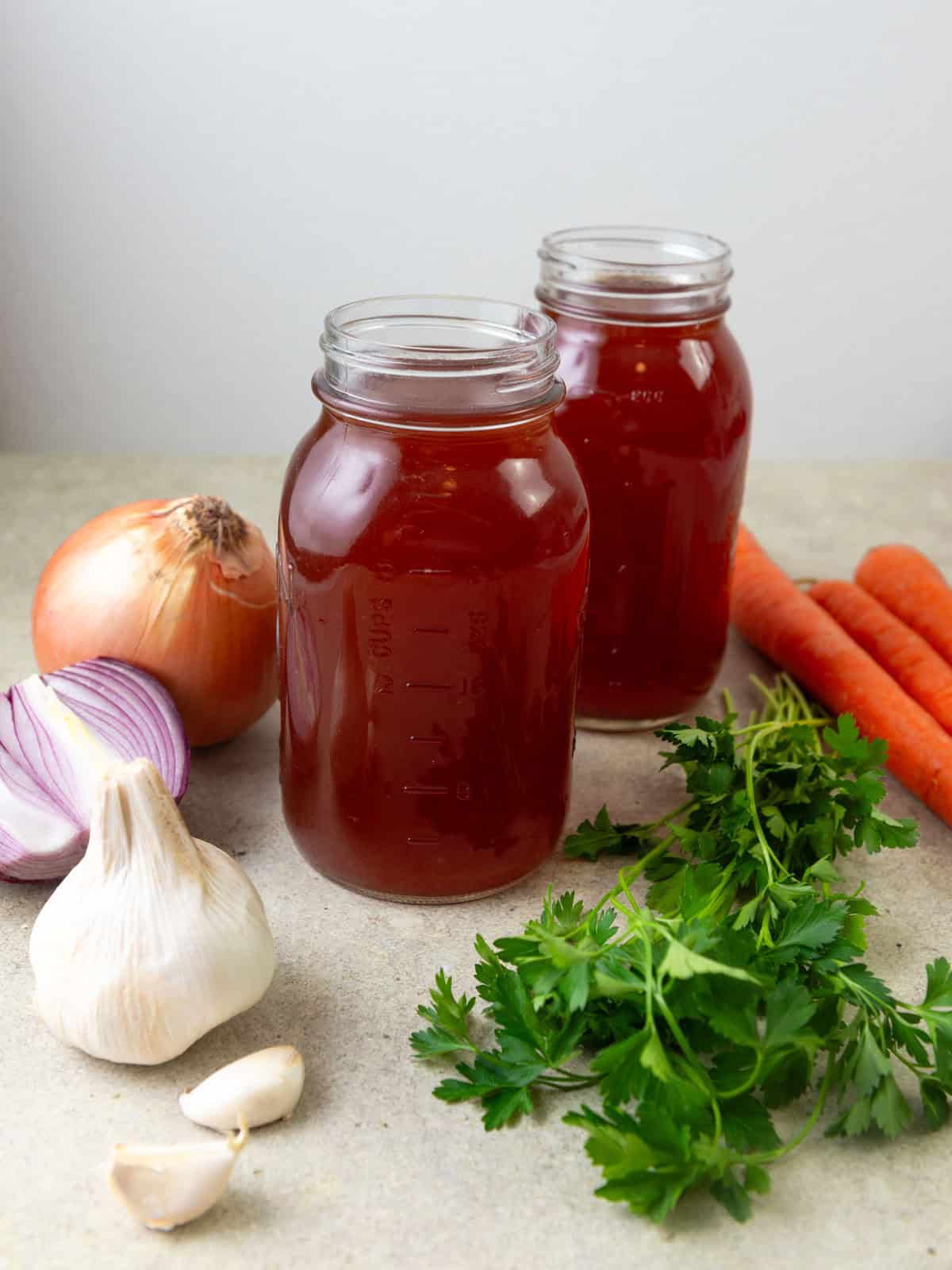
Jump to:
About This Recipe
This homemade vegetable stock is made entirely from veggie scraps you can save throughout the week. Things like onion peels, garlic skins, carrot ends, and celery roots. It’s an easy, sustainable way to reduce kitchen waste while creating a flavorful, versatile base for soups, stews, sauces, and grains.
Once your freezer bag is full, just empty it into a pot, cover with water, and add a few simple aromatics like bay leaves, whole peppercorns, and a pinch of salt. Let it simmer until the flavors deepen and the broth becomes golden and rich. It’s a simple method that yields a deeply satisfying result, and there are endless ways to use it in your everyday cooking.
📋 Vegetables That Work Well in Stock
Here’s a list of vegetables and herbs that are great for making stock. Use what you have, and mix it up depending on the season:
- Onion peels (yellow, white, or red—see notes below)
- Garlic skins
- Carrot peels and ends
- Celery root ends and leaves
- Tomato stems
- Broccoli stalks
- Mushroom stems
- Herb stems (parsley, cilantro, rosemary, thyme, etc.)
- Bell pepper cores and tops
- Fennel tops
- Corn cobs
- Stems from hardy greens like kale and chard
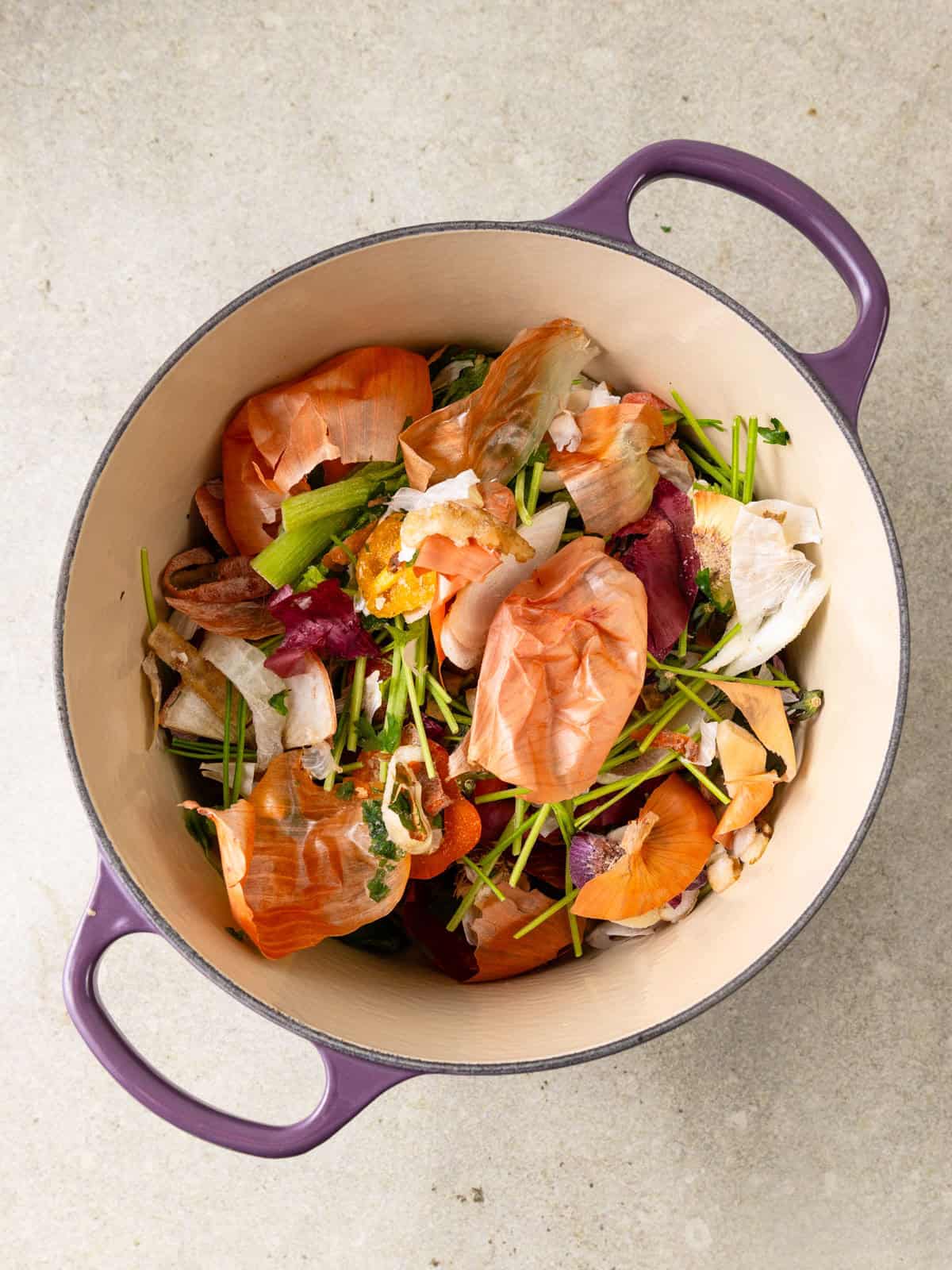
What to Avoid in Vegetable Stock
Not all vegetables make good stock. Here are a few I recommend skipping:
- Potatoes and zucchini – Too much water, and potatoes make the stock cloudy
- Cauliflower, cabbage, or Brussels sprouts – These cruciferous veggies can overpower the flavor
- Beet peels or stems – They’ll turn your stock pink or red
⏲️ Instructions
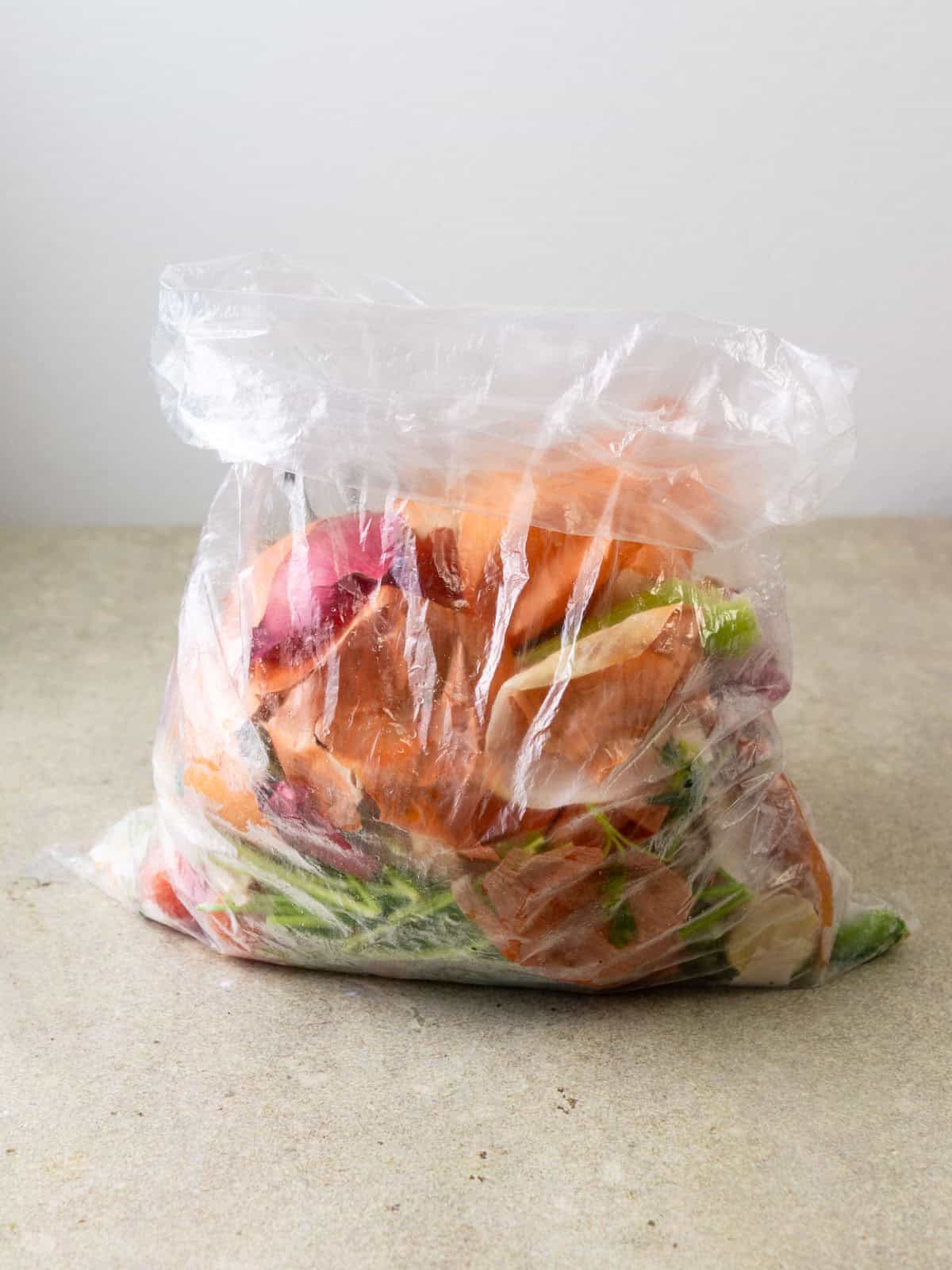
Collect & Store Scraps: As you cook, save vegetable scraps in a freezer-safe bag until you have about 1 to 2 pints (a produce bag about half full).

Simmer the Stock: Transfer the scraps to a medium-sized pot and fill with 5 to 6 cups of water, just enough to cover. Add bay leaves, peppercorns, and a pinch of salt (or skip if planning to salt later
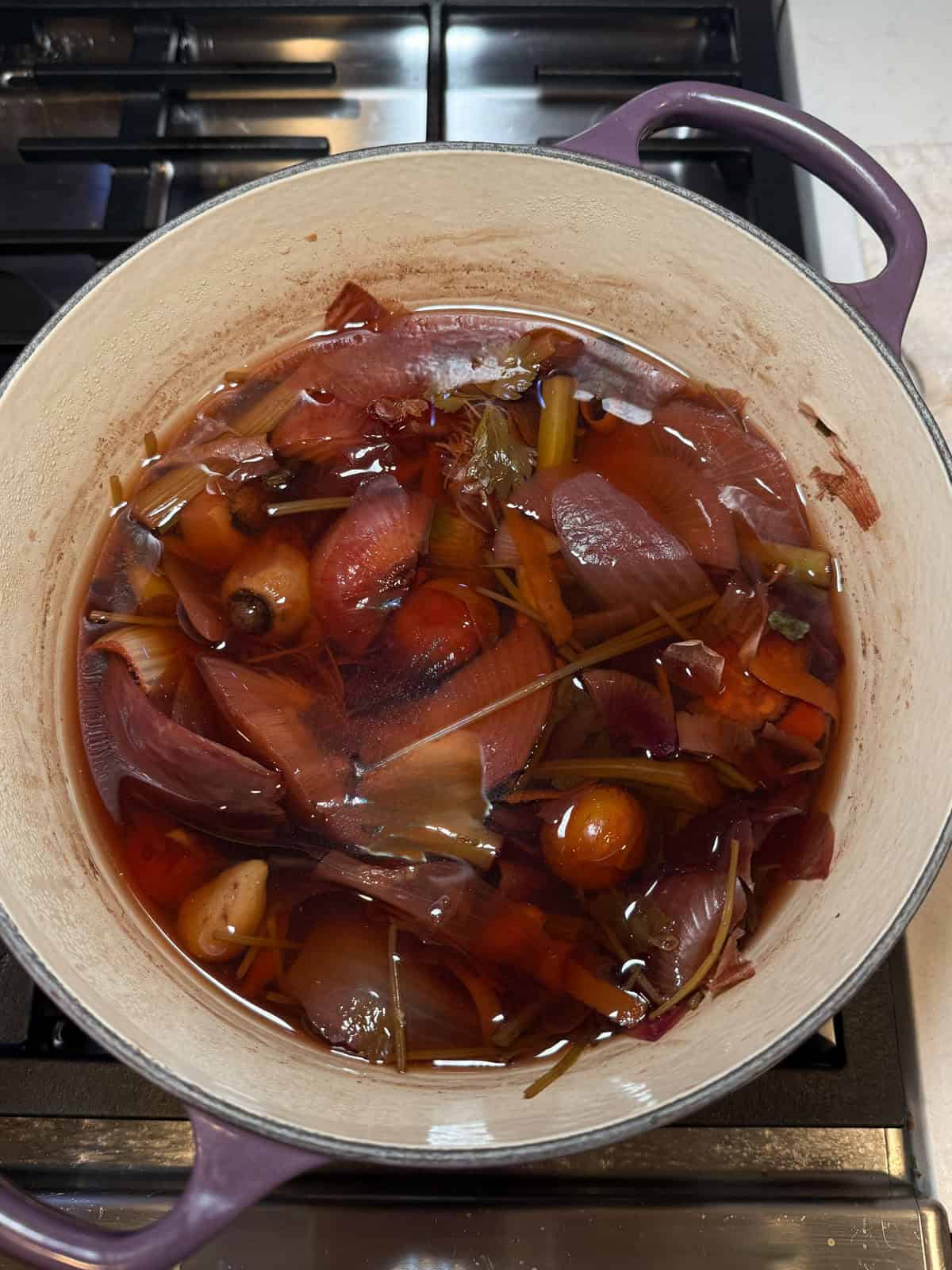
Cook: Bring to a gentle simmer over medium heat. Let cook for about 2 hours, or until the stock is deeply colored and fragrant.
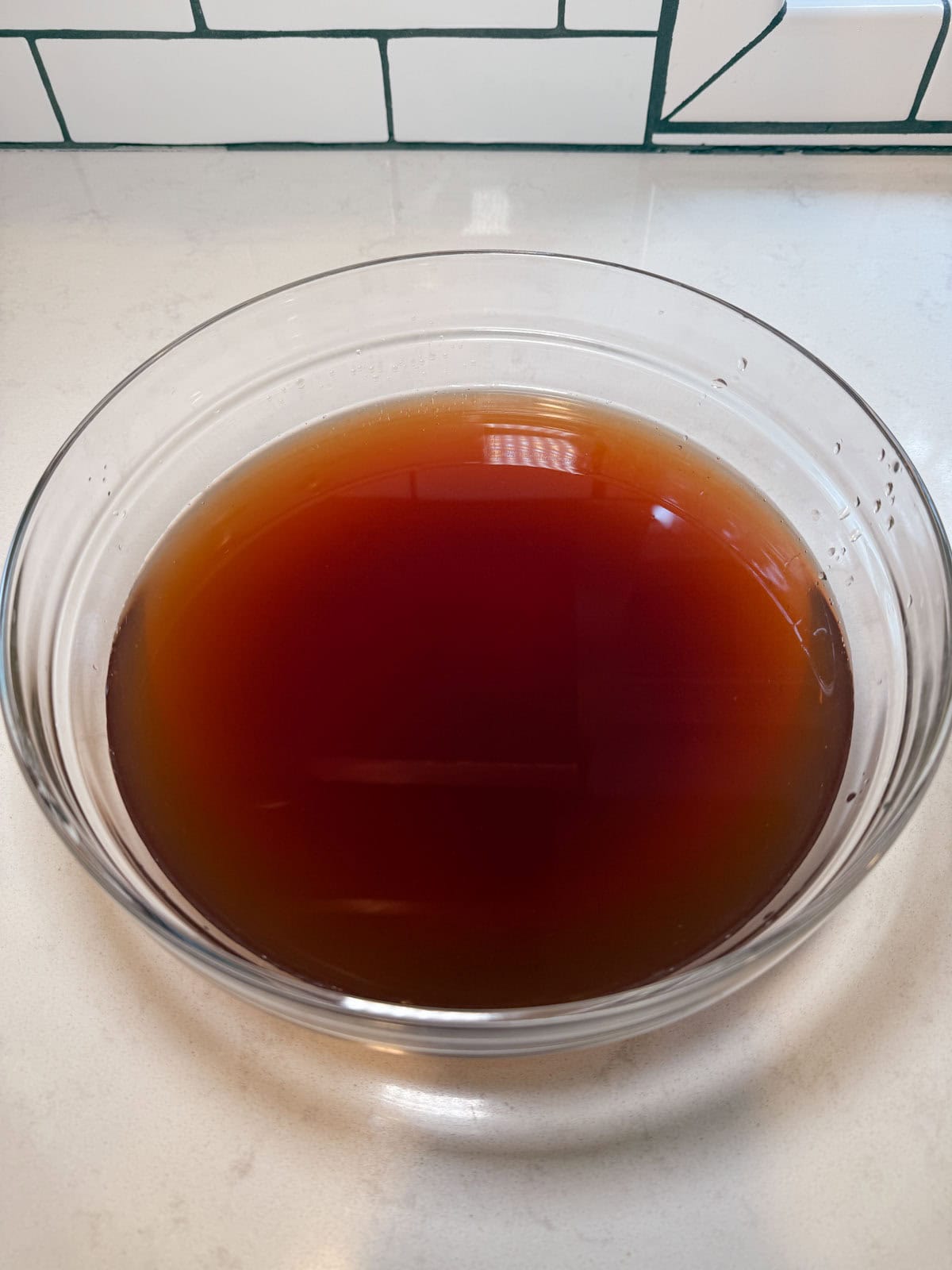
Strain: Let the stock cool slightly. Remove large vegetable pieces first, then strain the liquid through a fine-mesh sieve.
📍 Recipe Tips
- 💧 Don’t Overfill With Water: Only add enough water to cover the vegetables in the pot. Too much water can dilute the flavor of your stock.
- 🧅 Be Mindful of Onion Color: Red or purple onion skins can darken the color of the stock, but the flavor stays the same. If you prefer a lighter, golden stock, use yellow or white onion peels.
- 🌿 Add Flavor Boosters: Add 2 bay leaves and about 5–7 whole peppercorns for a deeper, more layered flavor. These are optional, but they make a nice difference.
- 🧂 Skip the Salt if Needed: If you plan to reduce the stock or use it in recipes that already include salt, leave the salt out of the stock to keep things balanced.
- 🚫 Toss Spoiled Scraps: Don’t use moldy or rotten vegetables. It’s fine if scraps are a little tired or soft, but anything spoiled should go in the compost or trash, not the stock pot.
How to Store Homemade Stock
This recipe yields about 6 cups of stock, which fits nicely into two medium mason jars. If you plan to use the stock within a week, store it in the fridge and use it in soups, stews, sauces, or grains.
For longer storage:
- Pour the cooled stock into resealable freezer bags
- Lay them flat on a baking sheet until frozen
- Once solid, stack and store in the freezer for up to 3 months
How to Use Vegetable Stock
Use this flavorful stock in place of water or store-bought broth to add richness to your meals. Here are a few ways I love to use it:
- Soups and stews: Use it as the base for cozy soups like Tuscan Bread Soup with Basil Oil, Vegetarian Pasta Fagioli, or Julia Child’s Vichyssoise.
- Risotto or creamy rice dishes: Vegetable stock is perfect for risotto recipes like Spring Leek and Spinach Risotto or Butternut Squash Risotto.
- Greek rice pilaf: Add it to your favorite pilaf like this Lemon Rice Pilaf or Mediterranean Rice for extra flavor.
- One-pot pastas: Use stock instead of water in recipes like this One-Pot Pasta with Spinach and Tomatoes for an added savory boost.
- Chicken-vegetable stock: Add leftover chicken bones or carcasses to your veggie scraps for a flavorful homemade chicken-vegetable stock.
- Seafood stock base: Combine it with shrimp shells or fish bones for a homemade Seafood Stock perfect for chowders, paella, or seafood stews.
More Soup Recipes To Try
Love this recipe? Please leave a 5-star 🌟🌟🌟🌟🌟rating in the recipe card below & a review in the comments section further down the page.

Homemade Vegetable Scrap Stock
LittleFerraroKitchen.com
Equipment
Ingredients
- About 1 to 2 pints of vegetable scraps Roughly a half-full produce bag. Such as onion peels, garlic skins, tomato stems, celery ends, carrot peels, and broccoli stems
- 5 to 6 cups water enough to cover the scraps
- 2 bay leaves
- 5 to 7 whole peppercorns
Instructions
- Collect & Store Scraps: As you cook, save vegetable scraps in a freezer-safe bag until you have about 1 to 2 pints (a produce bag about half full).
- Simmer the Stock: Transfer the scraps to a medium-sized pot and fill with 5 to 6 cups of water, just enough to cover. Add bay leaves, peppercorns, and a pinch of salt (or skip if planning to salt later
- Cook: Bring to a gentle simmer over medium heat. Let cook for about 2 hours, or until the stock is deeply colored and fragrant.
- Strain: Let the stock cool slightly. Remove large vegetable pieces first, then strain the liquid through a fine-mesh sieve.
- Store: Pour into mason jars (about 6 cups total) and refrigerate for up to 5 days. For longer storage, freeze in resealable bags—lay them flat in the freezer for easy stacking.
Notes
- 💧 Don’t Overfill With Water: Only add enough water to cover the vegetables in the pot. Too much water can dilute the flavor of your stock.
- 🧅 Be Mindful of Onion Color: Red or purple onion skins can darken the color of the stock, but the flavor stays the same. If you prefer a lighter, golden stock, use yellow or white onion peels.
- 🌿 Add Flavor Boosters: Add 2 bay leaves and about 5–7 whole peppercorns for a deeper, more layered flavor. These are optional, but they make a nice difference.
- 🧂 Skip the Salt if Needed: If you plan to reduce the stock or use it in recipes that already include salt, leave the salt out of the stock to keep things balanced.
- 🚫 Toss Spoiled Scraps: Don’t use moldy or rotten vegetables. It’s fine if scraps are a little tired or soft, but anything spoiled should go in the compost or trash, not the stock pot.
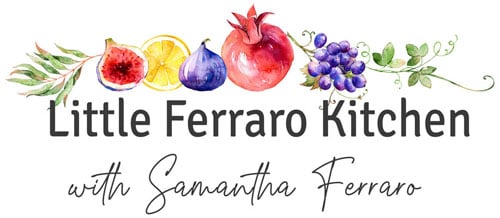

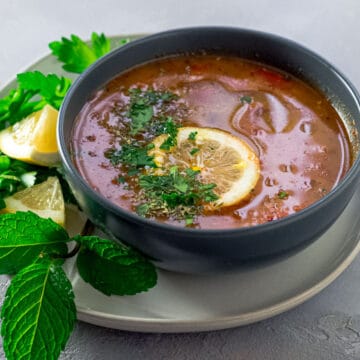







Patricia says
Easy to follow directions and thorough. I like this recipe because it was explicit, particularly with the cooking time.
Samantha Ferraro says
Wonderful Patricia, Thank you for the feedback, Samantha.
Foodbevguy says
Wow homemade stock is so much better than premade. The store bought has so much sodium. We saves all of our scraps for about 2 weeks and made 3 quarts of stock. A real money saver too.